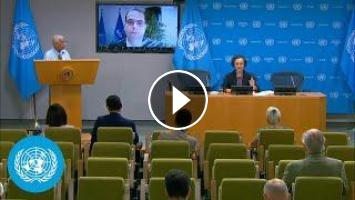Fourteen months into the conflict, Sudan is facing the worst levels of acute food insecurity ever recorded by the Integrated Food Security Phase Classification (IPC) in the country, with over half of the population (25.6M people) facing crisis or worse conditions (IPC Phase 3 or above) between June and September 2024, coinciding with the lean season, according to a new report released today (27 Jun).
This includes 755,000 people in Catastrophe (IPC Phase 5) in 10 states including Greater Darfur (all five states), South and North Kordofan, Blue Nile, Al Jazirah, and Khartoum. Another 8.5M people (18 percent of the population) face Emergency (IPC Phase 4).
Talking to reporters in New York, the Director of the Office of Emergencies and Resilience at the Food and Agriculture Organization (FAO), Rein Paulsen, said, “there is a risk of famine in 14 areas, localities and clusters affecting both residents, internally displaced people and refugees.”
Paulsen said that if the conflict escalates further, it will disrupt “mobility, humanitarian assistance, access to markets and livelihood activities.”
The United Nations Children’s Fund’s (UNICEF) Director of Emergency Programs, Lucia Elmi, said, “the lean season is starting soon. It would be very difficult to be able to reach certain areas as well. And so, it is not a matter of how long we have it, but how much more can we have access to them.”
Elmi said, “every single day is a tragedy for the largest displacement crisis in the world and the largest social protection crisis in the world for children. So, it is really a matter of urgency. And every minute counts.”
For his part, the Director of Emergencies at the World Food Program (WFP), Samer Abdel Jaber, said, “we have been collectively able to get some aid across the cross lines and cross border, but I think we need to make sure that it's sustainable and that is really important. We are able to see some commercial sector actually, able to move some commodities. And that's why all the monitoring partners, including WFP, are actually also using a cash-based operation to actually make sure that we stimulate those markets where it's functioning. But of course, from our side, we are also using in-kind assistance to help us navigate, some of those access challenges and do, if you can say, access negotiations.”
This latest IPC analysis marks a stark and rapid deterioration of the food security situation compared to the previous IPC update published in December 2023. Six months later, the number of people facing high levels of acute food insecurity has increased by 45 percent (from 17.7M to 25.6M), including a 74 percent increase (+3.6M) in IPC Phase 4, while the population in Catastrophe (IPC Phase 5) has surged from zero to 755,000 in the period June - September 2024. Compared to the same time last year (June 2023), the number of people classified in IPC Phase 3 or above has increased by over 50 percent (+8.7M).
The conflict has not only triggered mass displacement and disruption of supply routes, market systems and agricultural production, it has also severely limited access to essential humanitarian assistance, exacerbating an already dire situation. The impact of conflict extends beyond food insecurity. Reports from various states highlight highly dysfunctional health services, water contamination and poor sanitation and hygiene conditions. Increased morbidity to water-borne diseases is expected to further reduce the absorption capacity of the little food available for children and adults. Consequently, cases of acute malnutrition, which have already reached extremely high levels in some areas will likely increase. Moreover, the fast-approaching rainy season and expected floods will likely affect the agricultural season through the spread of pests and plant diseases.
This includes 755,000 people in Catastrophe (IPC Phase 5) in 10 states including Greater Darfur (all five states), South and North Kordofan, Blue Nile, Al Jazirah, and Khartoum. Another 8.5M people (18 percent of the population) face Emergency (IPC Phase 4).
Talking to reporters in New York, the Director of the Office of Emergencies and Resilience at the Food and Agriculture Organization (FAO), Rein Paulsen, said, “there is a risk of famine in 14 areas, localities and clusters affecting both residents, internally displaced people and refugees.”
Paulsen said that if the conflict escalates further, it will disrupt “mobility, humanitarian assistance, access to markets and livelihood activities.”
The United Nations Children’s Fund’s (UNICEF) Director of Emergency Programs, Lucia Elmi, said, “the lean season is starting soon. It would be very difficult to be able to reach certain areas as well. And so, it is not a matter of how long we have it, but how much more can we have access to them.”
Elmi said, “every single day is a tragedy for the largest displacement crisis in the world and the largest social protection crisis in the world for children. So, it is really a matter of urgency. And every minute counts.”
For his part, the Director of Emergencies at the World Food Program (WFP), Samer Abdel Jaber, said, “we have been collectively able to get some aid across the cross lines and cross border, but I think we need to make sure that it's sustainable and that is really important. We are able to see some commercial sector actually, able to move some commodities. And that's why all the monitoring partners, including WFP, are actually also using a cash-based operation to actually make sure that we stimulate those markets where it's functioning. But of course, from our side, we are also using in-kind assistance to help us navigate, some of those access challenges and do, if you can say, access negotiations.”
This latest IPC analysis marks a stark and rapid deterioration of the food security situation compared to the previous IPC update published in December 2023. Six months later, the number of people facing high levels of acute food insecurity has increased by 45 percent (from 17.7M to 25.6M), including a 74 percent increase (+3.6M) in IPC Phase 4, while the population in Catastrophe (IPC Phase 5) has surged from zero to 755,000 in the period June - September 2024. Compared to the same time last year (June 2023), the number of people classified in IPC Phase 3 or above has increased by over 50 percent (+8.7M).
The conflict has not only triggered mass displacement and disruption of supply routes, market systems and agricultural production, it has also severely limited access to essential humanitarian assistance, exacerbating an already dire situation. The impact of conflict extends beyond food insecurity. Reports from various states highlight highly dysfunctional health services, water contamination and poor sanitation and hygiene conditions. Increased morbidity to water-borne diseases is expected to further reduce the absorption capacity of the little food available for children and adults. Consequently, cases of acute malnutrition, which have already reached extremely high levels in some areas will likely increase. Moreover, the fast-approaching rainy season and expected floods will likely affect the agricultural season through the spread of pests and plant diseases.
- Category
- United Nations
- Tags
- UN, United Nations, UNGA
Be the first to comment













